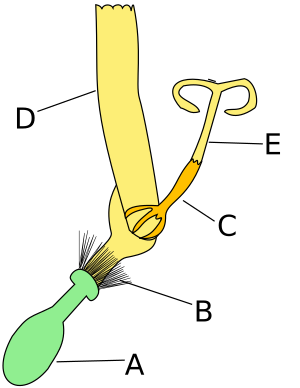Ligule
Ligule is a term used in botany and zoology with distinct meanings in each field. In botany, a ligule is a thin outgrowth at the junction of leaf and leafstalk of many grasses and sedges, serving as a protective barrier against pests and disease. In zoology, particularly in the anatomy of certain insects, a ligule can refer to various small, tongue-like structures.
Botanical Ligule
In the realm of botany, the ligule is an important morphological feature of the Poaceae (grass) family and some other monocotyledonous plants. It appears as a small, membranous, or hairy appendage at the base of the leaf blade, where the blade meets the sheath. The primary function of the ligule in plants is to prevent water from seeping into the sheath, thus protecting the plant from rot and fungal infections. The presence, absence, or type of ligule is a significant characteristic used in the identification and classification of grasses.
Types of Botanical Ligules
Botanical ligules can be categorized into several types based on their structure:
- Membranous ligules - These are thin, paper-like structures that can vary in size from very short to elongated.
- Hairy ligules - Consist of a row of hairs at the junction of the leaf blade and sheath.
- Ciliate ligules - A form of hairy ligule where the hairs form a fringe.
- Absent ligules - Some species do not have a ligule, which is also a notable characteristic for identification.
Zoological Ligule
In zoology, the term ligule can refer to structures in various animals, but it is most commonly associated with the mouthparts of certain insects. In this context, a ligule can be part of the feeding apparatus, aiding in the ingestion of food. The specific form and function of the ligule can vary significantly among different insect species, reflecting their diverse feeding habits and ecological niches.
Significance and Applications
The study of ligules, both in plants and animals, provides valuable insights into the evolutionary adaptations and ecological strategies of different organisms. In botany, understanding the form and function of ligules can aid in the identification of plant species, which is crucial for botanical research, conservation efforts, and agriculture. In zoology, the study of ligules and other anatomical features can help elucidate the feeding mechanisms and dietary preferences of insects, contributing to our knowledge of biodiversity and ecosystem dynamics.
Transform your life with W8MD's budget GLP-1 injections from $125.
W8MD offers a medical weight loss program to lose weight in Philadelphia. Our physician-supervised medical weight loss provides:
- Most insurances accepted or discounted self-pay rates. We will obtain insurance prior authorizations if needed.
- Generic GLP1 weight loss injections from $125 for the starting dose.
- Also offer prescription weight loss medications including Phentermine, Qsymia, Diethylpropion, Contrave etc.
NYC weight loss doctor appointments
Start your NYC weight loss journey today at our NYC medical weight loss and Philadelphia medical weight loss clinics.
- Call 718-946-5500 to lose weight in NYC or for medical weight loss in Philadelphia 215-676-2334.
- Tags:NYC medical weight loss, Philadelphia lose weight Zepbound NYC, Budget GLP1 weight loss injections, Wegovy Philadelphia, Wegovy NYC, Philadelphia medical weight loss, Brookly weight loss and Wegovy NYC
|
WikiMD's Wellness Encyclopedia |
| Let Food Be Thy Medicine Medicine Thy Food - Hippocrates |
Medical Disclaimer: WikiMD is not a substitute for professional medical advice. The information on WikiMD is provided as an information resource only, may be incorrect, outdated or misleading, and is not to be used or relied on for any diagnostic or treatment purposes. Please consult your health care provider before making any healthcare decisions or for guidance about a specific medical condition. WikiMD expressly disclaims responsibility, and shall have no liability, for any damages, loss, injury, or liability whatsoever suffered as a result of your reliance on the information contained in this site. By visiting this site you agree to the foregoing terms and conditions, which may from time to time be changed or supplemented by WikiMD. If you do not agree to the foregoing terms and conditions, you should not enter or use this site. See full disclaimer.
Credits:Most images are courtesy of Wikimedia commons, and templates, categories Wikipedia, licensed under CC BY SA or similar.
Contributors: Prab R. Tumpati, MD


